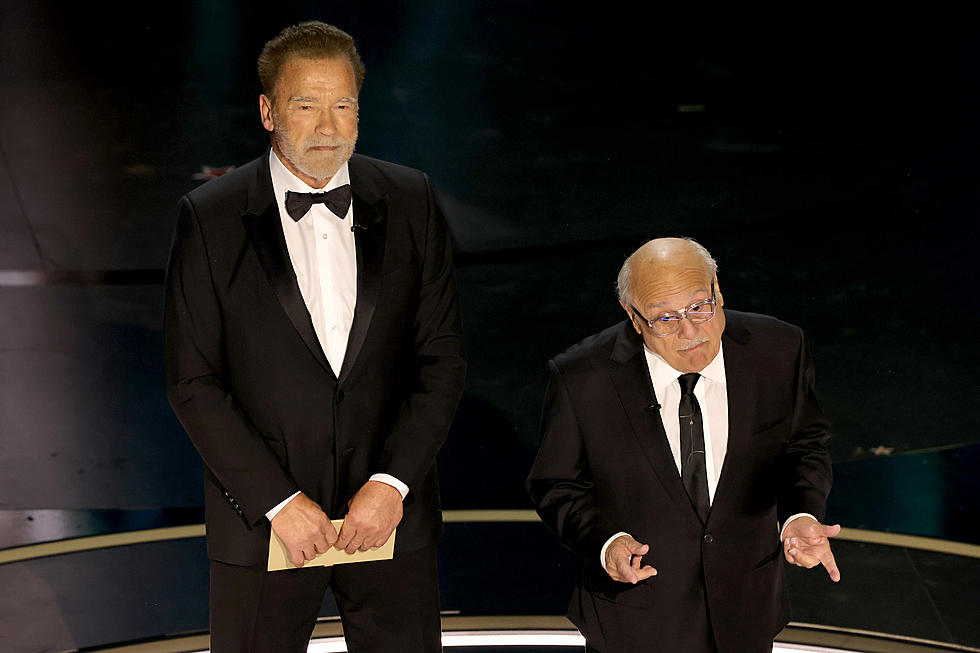
The Complete History of Comic-Book Movies, Chapter 3: ‘Batman’
ScreenCrush editor, comic-book lover, and undiagnosed masochist Matt Singer is systematically watching every single (American) comic-book movie ever made in the order in which they were released. This week in The Complete History of Comic-Book Movies: The Dark Knight makes his first appearance on the big screen:
‘Batman’ (1943)
Director: Lambert Hillyer
Writers: Victor McLeod, Leslie Swabacker, Harry Fraser
Starring: Lewis Wilson, Douglas Croft, J. Carrol Naish
Based on: Batman, created by Bob Kane and Bill Finger in ‘Detective Comics’ #27
Onscreen Iteration: First appearance
Best Special Effect:The big fistfight that caps off chapter 12 takes place in the middle of a raging inferno—or at least some very respectable fire effects.
Worst Special Effect: At the cliffhanger of chapter 7, Batman gets overpowered by goons and tossed down an elevator shaft. Or, more accurately, Batman gets overpowered by goons and then the least-convincing dummy in film history gets tossed down an elevator shaft. It’s so obviously phony, I was hoping the resolution of the cliffhanger would be Batman ducking out of sight, inflating a life-size Bat-dummy, dumping it, and then reappearing while yelling “You thought that was me lying at the bottom of that shaft? Look at how fake it looks! The criminal mind is weak and easily fooled!” Alas, no such luck.
Most Dated Moment: The antagonist of the serial, Dr. Daka, has a hideout in a part of Gotham City called “Little Tokyo.” There’s a lot about Daka and the Japanese characters in general that’s pretty dated (which is a nice way of saying it’s despicably racist), but the single most disgusting moment comes when the film’s narrator introduces Little Tokyo and explains that “since a wise government rounded up the shifty-eyed Japs, it has become virtually a ghost street.” Holy inexcusable xenophobia, Batman. (Watch at 9:20 of the clip below.)
Most Timeless Moment: At the climax of chapter 13, Batman falls into a pit with spiked walls which slowly close in on him. This is a classic gag that’s been used time and again in serials, television shows, and movies. The ’60s ‘Batman’ TV show paid homage to it in one episode, and variations have popped up in films like ‘Krull,’ ‘Army of Darkness,’ and, of course, ‘Star Wars,’ where Luke and company were nearly squished in a garbage compactor.
Further Thoughts: And you thought ‘Batman & Robin’ was bad.
1943’s ‘Batman’ is far and away the worst Batman movie I’ve ever seen. It might be the worst Batman anything in any medium period. The acting is poor, the writing is awful, the plot is repetitive, the action is uninspired, the runtime is an unbearable 260 minutes, and the racism on display is amongst the most shocking and repulsive in Hollywood history. The only people who should endure this disaster are pop-culture historians and people who hate themselves so much they feel a deep and implacable need to torture themselves. Watching the ‘Batman’ serial is like self-flagellation for comics fans.
Despite its revolting ethnic stereotyping and tedious story, the serial did make a fairly substantial impact on the Batman mythos. Most importantly, it introduced the Batcave (or, as it’s called here, “The Bat’s Cave”), where Batman (Lewis Wilson) and Robin (Douglas Croft) perform science experiments and occasionally interrogate captured saboteurs and thugs. Director Lambert Hillyer and his team also get credit for devising the cool secret entrance for the Batcave hidden inside a grandfather’s clock, a gimmick that became a staple of subsequent ‘Batman’ books. The actual cave itself is as bargain basement as they come—literally a phony-looking cave backdrop with an oddly ornate antique desk. Can you imagine how heavy that thing is? How did they even get it down the stairs into the cave? I bet Bruce made Alfred carry it.
Speaking of Alfred, he’s another element that the serial gets credit for. He existed in the comics prior to his depiction in the film, but in a different form; he looked chubbier and was clean-shaven. The serial’s Alfred, played by William Austin, was thin with a mustache, and before long the comic-book Alfred received a makeover to match his cinematic counterpart. These are the first instances of comics borrowing from the movies they inspired, a trend that continues to this day.
The ‘Batman’ serial also clearly inspired the 1960s ‘Batman’ television show, which took a number of its elements and recycled them as camp. The serial’s Batman and Robin constantly scale buildings with their Bat-ropes, even when they could clearly get where they’re going faster by taking the stairs or an elevator; the ‘Batman’ TV series simply amplified the absurdity by having them walk slowly on obviously horizontal sets while carrying on long conversations (or occasionally interacting with cameoing guest stars). The serial also features feverish cliffhangers and an over-excited narrator hyping the next dramatic installment “at this theater next week!” Both of those elements became trademarks of the Adam West Batman, which aired twice-weekly for most of its run and concluded the first half of each two-parter with a cliffhanger and the narrator imploring viewers to return tomorrow, “Same Bat-time, Same Bat-channel!”
So ‘Batman’’s importance to its title character’s evolution is substantial. But so is its cultural insensitivity. Granted, the serial was produced in 1943, at the height of World War II. It was a different time. But the characterization of Dr. Daka by J. Carrol Naish, a Caucasian actor in squinting yellowface, and the constant anti-Asian slurs—not to mention the casual justification of Japanese internment camps—go well beyond simple bigotry. (Curiously, numerous American characters comment on Daka’s “strange voice.” It’s hard to tell whether that’s an inside joke because Naish sounds nothing like an actual Asian person, or an implication on the part of the serial that all Japanese people have strange voices. Given the general level of prejuduce on display, I’m inclined the think it’s the latter.)
The rest of the serial isn’t much better. Where the two previous comic-book movies in this column, ‘Adventures of Captain Marvel,’ and ‘Spy Smasher,’ both contained a nice variety of thrilling fights and chases, ‘Batman’ runs an abysmal 15 chapters and rarely strays from a single recurring formula: Batman and Robin race to a location, Daka’s goons beat them up, Batman gets knocked out and then tossed over a ledge or left to die under a heavy object or at the bottom of a booby-trapped pit, before he finds a last-second escape (i.e. Robin comes and saves him).
The brawls themselves are dull and interchangeable. There’s none of the choreographic creativity or athleticism that director William Witney and his stunt team brought to ‘Spy Smasher.’ Even worse, Batman loses almost every single fight. He gets knocked unconscious constantly. Isn’t Batman supposed to be good at fighting? Isn’t that the main thing that makes him Batman? The ‘Batman’ serial’s Caped Crusader is basically a giant punching bag in the highest-waisted briefs ever worn by a human being. Look at those things! His utility belt practically touches his nipples.
When ‘Batman’ isn’t racist or boring, it’s lazy; there are a ton of continuity errors and baffling story turns. Batman will lose his cape in one shot, and in the next it’s miraculously back. Bruce Wayne and Dick Grayson talk about how they must protect their secret identities in order to remain effective agents of the government’s war against Japan, but then the government sends Bruce Wayne and Dick Grayson secret coded messages intended for Batman. (I guess FDR knows Batman is really Bruce Wayne?) Those coded messages set up one of the most surreal moments in the serial, when a close-up reveals Wayne Manor’s address in Los Angeles (at 1918 Hill Road, to be exact) after the narrator has already made it explicitly clear that it is located “high atop one of the hills which ring the teaming metropolis of Gotham City.” Did the prop department forget to read the script?
Lewis Wilson makes a terrible Batman, but he’s a decent Bruce Wayne; his flaky playboy routine makes a convincing cover for his extra-curricular activities as Batman. And William Austin has a couple nice moments of bumbling comic relief as Alfred; it’s easy to see why the comics quickly adapted his interpretation of the character back to the page. But that’s about all that’s worth recommending in a 260-minute slog. I absolutely hated this film. But hey, if you enjoy virulent racism and mediocre stunts, you’ll love ‘Batman.’
‘Batman’ is currently available in its entirety on YouTube. Note that the first chapter has 32,000 views, while the last has less than 1,300. That’s because it is not good.
More From ScreenCrush









